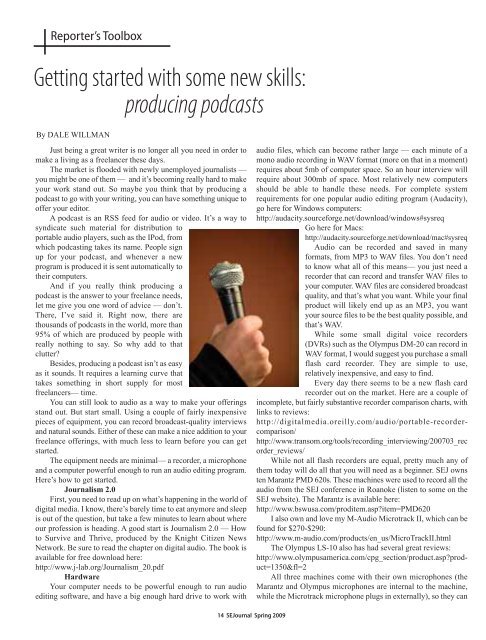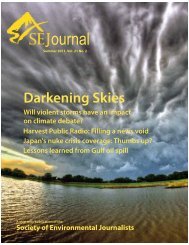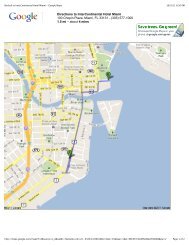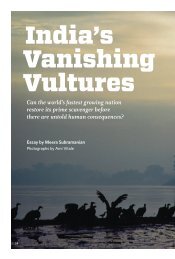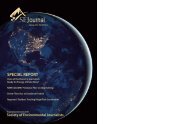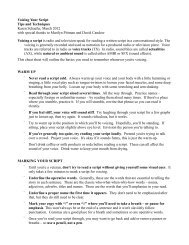PDF Download - Society of Environmental Journalists
PDF Download - Society of Environmental Journalists
PDF Download - Society of Environmental Journalists
Create successful ePaper yourself
Turn your PDF publications into a flip-book with our unique Google optimized e-Paper software.
Reporter’s ToolboxGetting started with some new skills:producing podcastsBy DALE WILLMANJust being a great writer is no longer all you need in order tomake a living as a freelancer these days.The market is flooded with newly unemployed journalists —you might be one <strong>of</strong> them — and it’s becoming really hard to makeyour work stand out. So maybe you think that by producing apodcast to go with your writing, you can have something unique to<strong>of</strong>fer your editor.A podcast is an RSS feed for audio or video. It’s a way tosyndicate such material for distribution toportable audio players, such as the IPod, fromwhich podcasting takes its name. People signup for your podcast, and whenever a newprogram is produced it is sent automatically totheir computers.And if you really think producing apodcast is the answer to your freelance needs,let me give you one word <strong>of</strong> advice — don’t.There, I’ve said it. Right now, there arethousands <strong>of</strong> podcasts in the world, more than95% <strong>of</strong> which are produced by people withreally nothing to say. So why add to thatclutter?Besides, producing a podcast isn’t as easyas it sounds. It requires a learning curve thattakes something in short supply for mostfreelancers— time.You can still look to audio as a way to make your <strong>of</strong>feringsstand out. But start small. Using a couple <strong>of</strong> fairly inexpensivepieces <strong>of</strong> equipment, you can record broadcast-quality interviewsand natural sounds. Either <strong>of</strong> these can make a nice addition to yourfreelance <strong>of</strong>ferings, with much less to learn before you can getstarted.The equipment needs are minimal— a recorder, a microphoneand a computer powerful enough to run an audio editing program.Here’s how to get started.Journalism 2.0First, you need to read up on what’s happening in the world <strong>of</strong>digital media. I know, there’s barely time to eat anymore and sleepis out <strong>of</strong> the question, but take a few minutes to learn about whereour pr<strong>of</strong>ession is heading. A good start is Journalism 2.0 — Howto Survive and Thrive, produced by the Knight Citizen NewsNetwork. Be sure to read the chapter on digital audio. The book isavailable for free download here:http://www.j-lab.org/Journalism_20.pdfHardwareYour computer needs to be powerful enough to run audioediting s<strong>of</strong>tware, and have a big enough hard drive to work withaudio files, which can become rather large — each minute <strong>of</strong> amono audio recording in WAV format (more on that in a moment)requires about 5mb <strong>of</strong> computer space. So an hour interview willrequire about 300mb <strong>of</strong> space. Most relatively new computersshould be able to handle these needs. For complete systemrequirements for one popular audio editing program (Audacity),go here for Windows computers:http://audacity.sourceforge.net/download/windows#sysreqGo here for Macs:http://audacity.sourceforge.net/download/mac#sysreqAudio can be recorded and saved in manyformats, from MP3 to WAV files. You don’t needto know what all <strong>of</strong> this means— you just need arecorder that can record and transfer WAV files toyour computer. WAV files are considered broadcastquality, and that’s what you want. While your finalproduct will likely end up as an MP3, you wantyour source files to be the best quality possible, andthat’s WAV.While some small digital voice recorders(DVRs) such as the Olympus DM-20 can record inWAV format, I would suggest you purchase a smallflash card recorder. They are simple to use,relatively inexpensive, and easy to find.Every day there seems to be a new flash cardrecorder out on the market. Here are a couple <strong>of</strong>incomplete, but fairly substantive recorder comparison charts, withlinks to reviews:http://digitalmedia.oreilly.com/audio/portable-recordercomparison/http://www.transom.org/tools/recording_interviewing/200703_recorder_reviews/While not all flash recorders are equal, pretty much any <strong>of</strong>them today will do all that you will need as a beginner. SEJ ownsten Marantz PMD 620s. These machines were used to record all theaudio from the SEJ conference in Roanoke (listen to some on theSEJ website). The Marantz is available here:http://www.bswusa.com/proditem.asp?item=PMD620I also own and love my M-Audio Microtrack II, which can befound for $270-$290:http://www.m-audio.com/products/en_us/MicroTrackII.htmlThe Olympus LS-10 also has had several great reviews:http://www.olympusamerica.com/cpg_section/product.asp?product=1350&fl=2All three machines come with their own microphones (theMarantz and Olympus microphones are internal to the machine,while the Microtrack microphone plugs in externally), so they can14 SEJournal Spring 2009


